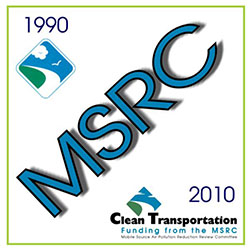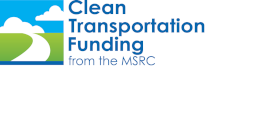 Next year will mark the 20th anniversary of the formation of the MSRC and its first-ever work program. Some of the groundbreakers who were there at the beginning have fond memories of coming together to create this one-of-a-kind organization.
Next year will mark the 20th anniversary of the formation of the MSRC and its first-ever work program. Some of the groundbreakers who were there at the beginning have fond memories of coming together to create this one-of-a-kind organization.
The MSRC was created by California Assembly Bill 2766, authored by legendary former Assemblyman and Senator Byron Sher. The law was enacted to provide Clean Transportation Funding to projects that reduce air pollution from mobile sources, funded through a small surcharge on vehicle license fees. Regional policymakers recognized that the South Coast basin faced unique air quality challenges, and therefore additional measures needed to be taken to address these problems. Thus, the MSRC was born.
Eric Haley recalls that creating the MSRC was not an easy task; in fact, the original legislation authorizing the Committee was vetoed. "In the early days, there were some jurisdictional-related issues about who should be in charge of the money. The bill presented a substantial change in how transportation funding for air quality was to be dealt with, which is why these issues arose." However, once these issues were ironed out, Eric said, "AB 2766 represented a watershed moment because it put transportation commissions in a more direct relationship with planning for air quality." Eric first got involved with the MSRC as a Government and Legislative Affairs staff member at SCAG and later served as a representative of SANBAG from 1990-1998.
"AB 2766 funding was so important to the introduction, acceptance and acceleration of clean transportation technologies and strategies. Had this funding not been there in the beginning, growth would have been impeded in these areas," said Lillian Kawasaki, former General Manager of the City of Los Angeles' Environmental Affairs Department, which was responsible for the AB 2766 funds for the city. "The funding also helped highlight the critical role that reducing our mobile source emissions would have to play if we were to achieve our air quality goals."
"The initial days were an example of the first time transportation commissions came together to establish a brand new organization with other regional representatives," remembered Marilyn Williams, former Director of Regional Programs and Public Affairs for the Riverside County Transportation Commission and one of the longest-serving TAC members until she retired in 2006. "For a transportation commission, it was a unique opportunity to represent the good of the region, rather than just representing the interest of our own county," she said.
As the first-of-its-kind agency, the MSRC had to establish its own procedures and criteria for developing the work plan. "We had the opportunity to shape those roles and responsibilities and it was exciting because we didn't know where we were going, there was no roadmap to follow" Marilyn noted.
In developing the work program categories and then evaluating the proposals once they came in, the Committee burned a lot of midnight oil. Marilyn recounts, "there were a lot of long, late hours, but we were all happy to do it. It was how we grew as a team. We all had such different backgrounds so the opportunity for growth and learning from one another was tremendous, and we fed off of that."
As the proposal process developed, the MSRC convened sub-committees to create the project categories and evaluate proposals that were submitted for their specific category. Then, to ensure a thorough review, the sub-committees switched amongst themselves in a type of blind-review, so that proposals were looked at from all perspectives. "When we were receiving 30 or more proposals per category, there was a great deal of humor involved because of the endless hours," Marilyn remarked.
Lillian also emphasized how important the development of the MSRC process was to the success of the committee. "It was a process that was objective, technically based, and had strong reporting requirements. With many other funding programs, the process is so politically driven."
Eric recalled that the MSRC's first work program had approximately $12 million in funding available, and the total amount requested in proposals greatly exceeded the amount of funding on hand - , a challenge that the MSRC continues to faces today. Some of the MSRC's very first contractors have continued to be project partners over the years. San Bernardino County, the Orange County Transportation Authority, and SCAG together were awarded more than $600,000 in funding for the first work program, and have received a total of more than $12 million combined since 1991.
Eric, Lillian and Marilyn are all very proud of the projects the MSRC helped fund because the Committee became a leader in research and development, advanced technology, and advancing new transportation concepts.
Eric told the story of the MSRC's venture into the electric vehicle (EV) wave of the early 1990s. The EV1 consumer buydown program allocated $5 million for EVs, and offered $5,000 grants to EV buyers and lessors. "We jumped into it aggressively, but the program ultimately failed because the market didn't mature, the mandate from ARB went away, and the rest of the manufacturers weren't into it like GM was, and maybe GM's heart really wasn't in it." However, looking back on the project, he doesn't see it as a failure now. "It was by far and away the most dramatic project we undertook and it will have the biggest impact in the long run. The MSRC helped develop new technology by working with the auto manufacturers and helped jump start the battery programs for some, and the success of hybrids and the new EVs coming online now stems from this era."
Of course, the bread and butter for the MSRC back then, as now, was focused on cleaning up dirty diesel vehicles and advancing clean fuels. But, Marilyn was also equally proud of what she terms the "soft-sided" projects, like commuter-assistance programs such as the Freeway Service Patrol, the 'Pick-a-Day-Any-Day' rideshare campaign, and regional vanpooling projects.
Looking at how the MSRC has evolved, Marilyn says, "the design and development of projects is becoming increasingly more specialized because of the incremental air quality benefits that must be met, making it more of a challenge today than originally." Eric characterizes the MSRC as "still an evolving success story."
Lillian sees that many things that they were working on 20 years ago are coming full circle, like EVs and making the connection between mobile sources and the bigger environmental picture. "Back then, it was the integration of transportation and clean air. Now, it's clear that if we dont tackle mobile sources, we won't be able to achieve our global warming targets."
All three believe that the continued service and commitment of the members of the MSRC is one of the things that makes the Committee so special. Eric said, "the MSRC was cutting-edge in building a consensus for transportation and air quality, but by its nature it was also political, but this became less so over time as people became more sophisticated and the politics fell away. With long-term commitments, there was institutional memory that a lot of other groups don't achieve." Lillian added, "the structure of the Committee and the members' commitment is why the program has lasted all these years."
Marilyn agrees. "The longevity of the elected officials on the Committee is reflective of the opportunities that the MSRC gives to serve the region. It goes beyond the local perspective and is such a source of pride. Once you are a part of it, it's hard to let go. It's why I never left until I retired."
Marilyn summed up her memories of the MSRC by commenting that the phrase 'making a difference' is sometimes overused but, "in this case, with the MSRC, it's absolutely true. You see and breathe the difference."
To commemorate the 20th anniversary of the MSRC's first work program, the MSRC will be holding an event in early 2011 to celebrate. Please watch the MSRC's website for more details about the upcoming celebration.
Pictured below: Just some of the amazing projects the MSRC has helped fund over the years.
